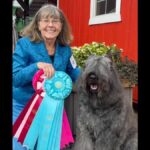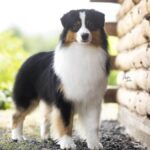Judging the Sealyham Terrier
These words come to mind when describing the Sealyham Terrier: power, strength, and determination. Those words are also used in the AKC breed standard. The Sealyham Terrier is a low-legged, broad, well-boned, athletic Terrier. This charming breed is comical, social and loving.
The Sealy should not be a course or clumsily built dog. The Sealy should weigh between 23 and 24 pounds, which is a lot for a low-legged terrier that is 10-1/2 inches at the shoulders. They are a lot to carry! Size is to be considered much more than weight, but keep in mind there is a lot of bone, body and muscle in this package.
Sealyham Terriers are generally very outgoing and should show their enthusiasm in the ring. They should be able to stand on their own, with their tails up and ears alert. Most handlers will bend down with them when lined up in the ring. They also do not like to stand still. When moving, they should move true and sound with strength, which should result in good reach and drive.
When examining the Sealy on the table, you should be able to approach them with ease. The Sealy head should not be coarse. It should be in balance with the body. The head is slightly domed with a strong back skull. There is a very shallow ridge between the brows. The head planes should be level. The muzzle should have strength and width. The foreface and back skull should be equal in balance. The cheeks should be balanced with no coarseness. There should be a slight stop. The breadth between the ears should be less than half the length between the head. The bite should be scissors or level; any deviation is a bad fault.
Eyes should be dark and oval, with a keen expression. Larger, light eyes are a fault. It is important to note that lack of eye pigment is not a fault. The Sealy ear should fall level from the top of the head. The front of the ear should fall next to the cheek, and when pulled forward should reach the corner of the head.
The Sealy neck should be set firmly on the shoulder with a well laid back shoulder. The shoulder should be smooth yet broad enough to allow free movement. Straight or upright shoulders should be penalized. The Sealy front legs are well-boned with large, compact feet. They should be straight. The chest should be well let down between the legs. The rear legs are slightly less boned with a let down, well-angulated hock and a strong second thigh. The Sealy body is strong and the ribs well sprung. Slab-sided dogs are not acceptable.
The body is solid and short. The body should be deep and the chest should fall below the elbow when examined from the side. The length of back from the withers to the set on the tail should be square. However, this is not a short-backed breed. It is important to realize that the Sealyham Terrier should be rectangular in shape, 10-1/2 inches from the withers to the set on the tail, due to the tail set and protruding hind quarters (with angulation and a short hock, and the correct front assembly). The topline is level whether standing or moving.
I would encourage judges to spar the Sealyham. They generally are not super aggressive with other dogs. They should stand there, acknowledging the other dog or bitch.
Any head marking on a Sealyham Terrier head are acceptable. When you are judging, you may see Sealies with body markings. This is not a fault; however, it is discouraged. The Sealy coat is very different from other terriers. It is a weather resistant, harsh outer coat with the undercoat much more soft and dense than other Terrier breeds. Trimming and maintenance of this breed is highly difficult. As a judge, please try to encourage new exhibitors of this breed in the ring. We need to embrace everyone interested in this rare breed.
Sealyham Terriers are wonderful pets. They love the people that take care of them and they are quite comical characters.









